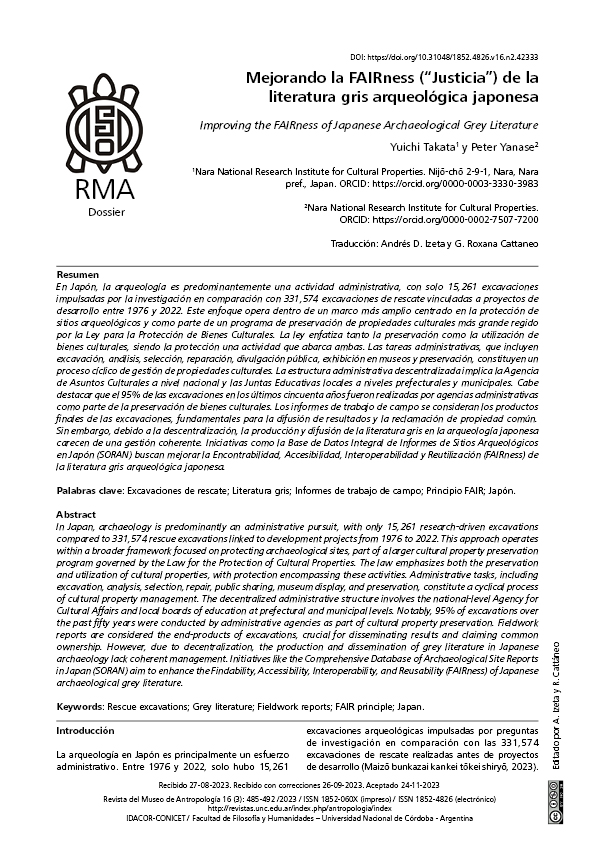Improving the FAIRness of Japanese Archaeological Grey Literature
DOI:
https://doi.org/10.31048/1852.4826.v16.n2.42333Keywords:
Rescue excavations, Grey literature, Fieldwork reports, FAIR principle, JapanAbstract
In Japan, archaeology is predominantly an administrative pursuit, with only 15,261 research-driven excavations compared to 331,574 rescue excavations linked to development projects from 1976 to 2022. This approach operates within a broader framework focused on protecting archaeological sites, part of a larger cultural property preservation program governed by the Law for the Protection of Cultural Properties. The law emphasizes both the preservation and utilization of cultural properties, with protection encompassing these activities. Administrative tasks, including excavation, analysis, selection, repair, public sharing, museum display, and preservation, constitute a cyclical process of cultural property management. The decentralized administrative structure involves the national-level Agency for Cultural Affairs and local boards of education at prefectural and municipal levels. Notably, 95% of excavations over the past fifty years were conducted by administrative agencies as part of cultural property preservation. Fieldwork reports are considered the end-products of excavations, crucial for disseminating results and claiming common ownership. However, due to decentralization, the production and dissemination of grey literature in Japanese archaeology lack coherent management. Initiatives like the Comprehensive Database of Archaeological Site Reports in Japan (SORAN) aim to enhance the Findability, Accessibility, Interoperability, and Reusability (FAIRness) of Japanese archaeological grey literature.
Downloads
References
Maizō bunkazai kankei tōkei shiryō: Reiwa 4 nendo. (2023). Bunkachō Bunkazai Dai Ni Ka. https://www.bunka.go.jp/seisaku/bunkazai/shokai/pdf/93861801_01.pdf [Last accessed: 26 July 2023].
Tanaka, N. (1984). Japan. In H. Cleere (Ed.), Approaches to the Archaeological Heritage: A Comparative Study of World Cultural Resource Management Systems (pp. 82–88). Cambridge University Press.
Nishiyama, N. (2015). Heritage Management in Present-day Japan. In J. Babb (Ed.), The SAGE Handbook of Modern Japanese Studies (pp. 80–98). SAGE Publications.
Japan: Law for the Protection of Cultural Property. (2009). Japan Center for International Cooperation in Conservation, National Research Institute for Cultural Properties: Tokyo.
Okamura, K. (2011). From Object-Centered to People-Focused: Exploring the Gap Between Archaeologists and the Public in Contemporary Japan. In K. Okamura & A. Matsuda (Eds.), New Perspectives in Global Public Archaeology (pp. 77–86). Springer.
Gyōsei mokuteki de okonau maizō bunkazai no chōsa ni tsuite no hyōjun. (2004). Maizō Bunkazai Hakkutsu Chōsa Taisei Tō No Seibi Jūjitsu Ni Kansuru Chōsa Kenkyū Iinkai. https://www.bunka.go.jp/seisaku/bunkazai/shokai/pdf/hokoku_06.pdf [Last accessed: 26 July 2023].
Bunkachō Bunkazai Bu Kinenbutsu Ka & Nara Bunkazai Kenkyūjo. (2010). Hakkutsu chōsa no tebiki: Seiri, hōkokusho. Monuments and Sites Division, Agency for Cultural Affairs.
Nara Bunkazai Kenkyujō. (2022) Nara Bunkazai Kenkyujō gaiyō 2022. Nara Bunkazai Kenkyujō. http://doi.org/10.24484/sitereports.130391 [Last accessed: 26 July 2023].
Maizō bunkazai hogo gyōsei ni okeru dejitaru gijutsu no dōnyū ni tsuite 1. (2017) Maizō Bunkazai Hakkutsu Chōsa Taisei Tō No Seibi Jūjitsu Ni Kansuru Chōsa Kenkyū Iinkai. http://doi.org/10.24484/sitereports.71612 [Last accessed: 26 July 2023].
Maizō bunkazai hogo gyōsei ni okeru dejitaru gijutsu no dōnyū ni tsuite 2. (2017) Maizō Bunkazai Hakkutsu Chōsa Taisei Tō No Seibi Jūjitsu Ni Kansuru Chōsa Kenkyū Iinkai. http://doi.org/10.24484/sitereports.71613 [Last accessed: 26 July 2023].
Maizō bunkazai hogo gyōsei ni okeru dejitaru gijutsu no dōnyū ni tsuite 3. (2019) Maizō Bunkazai Hakkutsu Chōsa Taisei Tō No Seibi Jūjitsu Ni Kansuru Chōsa Kenkyū Iinkai. http://doi.org/10.24484/sitereports.71614 [Last accessed: 26 July 2023].
Takata, Y. (2023) 2022 nendo sūji de miru zenkoku iseki hōkoku sōran. In Y. Takata (Ed.), Dejitaru gijutsu ni yoru bunkazai jōhō no kiroku to rikatsuyō 5: LiDAR, 3D dēta, dejitaru ākaibu, SNS, GIS, chitekizaisan ken. http://doi.org/10.24484/sitereports.130529 [Last accessed: 26 July 2023].

Downloads
Published
Issue
Section
License
Copyright (c) 2023 Yuichi Takata, Peter Yanase

This work is licensed under a Creative Commons Attribution-NonCommercial-ShareAlike 4.0 International License.
Those authors who have publications with this Journalaccept the following terms:
a. Authors will retain their copyrights and guarantee the journal the right of first publication of their work, which will be simultaneously subject to the Creative Commons Attribution License (Licencia de reconocimiento de Creative Commons) that allows third parties to share the work as long as its author and his first publication in this journal.
b. Authors may adopt other non-exclusive licensing agreements for the distribution of the version of the published work (eg, deposit it in an institutional electronic file or publish it in a monographic volume) provided that the initial publication in this journal is indicated.
c. Authors are allowed and recommended to disseminate their work on the Internet (eg in institutional telematic archives or on their website) before and during the submission process, which can lead to interesting exchanges and increase citations of the published work. (See The Effect of Open Access - El efecto del acceso abierto)











